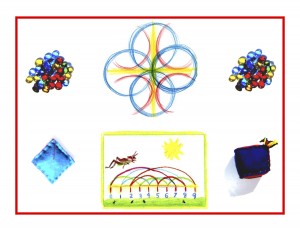Day 97
For one year, 365 days, this blog will address the Common Core Standards from the perspective of creating an alternate, ambient learning environment for math. Ambient is defined as “existing or present on all sides, an all-encompassing atmosphere.” And ambient music is defined as: “Quiet and relaxing with melodies that repeat many times.”
Why ambient? A math teaching style that’s whole and all encompassing, with themes that repeat many times through the years, is most likely to be effective and successful. Today’s post will continue with the Common Core Standards for Grade 1, listed in blue and followed by their ambient counterparts.
Operations and Algebraic Thinking 1.OA
Understand and apply properties of operations and the relationship between addition and subtraction.
3. Apply properties of operations as strategies to add and subtract. Examples: if 8 + 3 = 11 is known, then 3 + 8 = 11 is also known. (Commutative property of addition.) To add 2 + 6 + 4, the second two numbers can be added to make a 10, so 2 + 6 + 4 = 2 + 10 = 12. (Associative property of addition.)
Math By Hand introduces all three properties: associative, commutative, and distributive, in the Grade 2 Daily Lesson Plans book, in a thoroughly concrete and playful way. When concepts are presented too abstractly too soon, it results in confusion, anger, and loss of confidence. This is what we see happening with the protest by parents trying to understand and help their children with Common Core homework. And with parents deciding to opt their children out of testing because it will likely fail them, even those who were high math achievers until the Common Core came along.
The “high stakes” nature of the testing has put teachers and children at risk: failure, mislabeling as learning challenged, and losing a grade for children, censure and job loss for teachers. High stakes then becomes high stress, for teachers, children, and parents alike. It would be immeasurably better for Grades 1-3 (Kindergarten is intentionally omitted) to learn the basics first, before tackling the more abstract properties. There certainly can be some flexibility within this though, as mentioned yesterday. When using the color strips, the blank, white square can be placed anywhere to represent either the answer or a missing number. This allows a flexibility of thinking that can later translate to algebraic concepts.
As previously stated, working with all 4 processes at once allows a broader, more effective comparison. Knowledge ensues in an environment dedicated to imaginative, creative knowing, where student and teacher alike surrender to the ensuing of that knowledge as a worthy goal. Tune in tomorrow for more on the Common Core Grade 1 Operations and Algebraic Thinking Standards along with their ambient counterparts.












